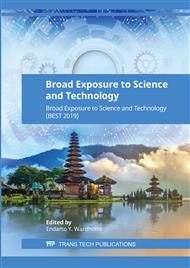p.137
p.144
p.153
p.162
p.169
p.175
p.182
p.192
p.200
Synthesys and Characterization of PLA-CNC Matrix for Antidiabetic Drug Release Applications
Abstract:
Recently, drug nanoparticles formulation using Poly Lactic Acid-Cellulose nanocrystal (PLA-CNC) have been introduced. PLA-CNC were prepared by emulsion method for antidiabetic drug delivery applications. PLA is one of polymer which potentially used as raw material of drug delivery because it has the ability to bind and carry drugs into cell target, but the hydrophilic character of PLA can cause the degradation of PLA in the body run slowly, so it is necessary combining PLA with CNC to improve its property. In this study, special attention has been given to the modification of PLA-CNC as a drug delivery matrix to obtain the optimum drug release of antidiabetic drugs. In this study drug release analysis was conducted at 35-39 °C and pH range 3 to 9 with varied of time dissolution 0 to 180 min. PLA-CNC matrixs were characterized using FTIR and SEM, its drug loading capacity, encapsulation efficiency and in vitro drug release behavior was determined by using UV spectrophotometer. It gave the initial burst release at the first hour at 37 °C pH 3.
Info:
Periodical:
Pages:
169-174
Citation:
Online since:
April 2020
Keywords:
Price:
Сopyright:
© 2020 Trans Tech Publications Ltd. All Rights Reserved
Share:
Citation:


